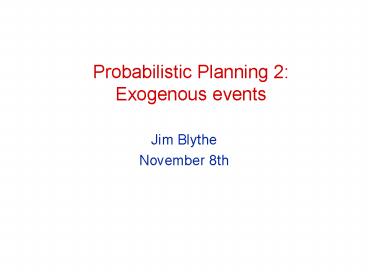Probabilistic Planning 2: Exogenous events PowerPoint PPT Presentation
1 / 21
Title: Probabilistic Planning 2: Exogenous events
1
Probabilistic Planning 2Exogenous events
- Jim Blythe
- November 8th
2
Assumptions (until October..)
- Atomic time
- All effects are immediate
- Deterministic effects
- Omniscience
- Sole agent of change
- Goals of attainment
3
Recap uncertainty from external change
- External agents might be changing the world while
we execute our plan.
4
Representing external sources of change
- Model actions that external agents can take in
the same way as actions that the planner can
take. - (event oil-spills
- (probability 0.1)
- (preconds
- (and (oil-in-tanker ltsea-sectorgt)
- (poor-weather ltsea-sectorgt)))
- (effects
- (del (oil-in-tanker ltsea-sectorgt))
- (add (oil-in-sea ltsea-sectorgt))))
5
Random external processes
- Some agents, like robot agent X, have intentions,
beliefs and desires, and their actions are based
on planning - May be co-operative, neutral or adversarial
- Some external agents like weather, can be
thought of as random processes - Not affected by knowledge of our goals
- Cant argue with forces of nature
- But sometimes we can influence random processes
indirectly, through states of the world that
affect their outcomes.
6
Impact of random events on planning
- Many random events are constantly taking place in
most domains in which we execute plans - Most do not affect the plans we execute
- Given a plan being considered
- (e.g. move a barge to some location, use it to
clean up spilled oil), - we can find the random events that do matter
- (e.g. the weather at that location, how spread
out the oil is)
7
Difficulty of handling random events
- Harder than uncertain action outcomes
- Have to find the relevant events
- Effects take place asynchronously
- Easier than co-operative or adversarial planning
in general - No communication of goals, plans
- No second-guessing other agents
- Question does having uncertaint external events
increase the expressivity of a planner that
already has uncertain action outcomes?
8
Improving plans affected by random events
- Add a conditional branch
- Try to decrease the probability of a bad event,
by decreasing the probability of its
preconditions or shortening the time during which
it can happen. - Sometimes select a random event as part of a plan
(e.g. to wash a car, leave it outside and wait
for rain) - then try to increase probability by increase
probability of preconditions or waiting longer.
9
Example events governing an oil-spill cleanup
problem
- The oil-spills event from an earlier slide, and
- (event weather-brightens
- (probability 0.25)
- (preconds (poor-weather))
- (effects
- (del (poor-weather))
- (add (fair-weather))))
10
Semantics of STRIPS-style representation of
external events
- Many different interpretations might be possible
- In Blythe 96, assume that at each time point, any
event that could take place does so with the
probability given in the event.
11
Evaluating a plan in the oil-spill domain
- Given this non-deterministic operator
- (operator move-barge
- (preconds (at ltbargegt ltfromgt))
- (effects
- (0.667
- (del (at ltbargegt ltfromgt))
- (add (at ltbargegt lttogt)))
- (0.333
- (del (at ltbargegt ltfromgt))
- (add (at ltbargegt lttogt))
- (del (operational ltbargegt)))))
12
Consider this conditional plan
- (move barge1 dock spill-site)
- IF (operational barge1)
- THEN
- (pump oil barge1)
- ELSE
- (move barge2 further-dock spill-site)
- (pump oil barge2)
- Pump-oil has preconds (operational ltbargegt) and
(fair-weather). - Move takes some time depending on the distance.
13
Computing the probability of success1 forward
projection
14
Computing probability of success2 constructing
a belief net from the plan
- Add nodes for actions and literals, then
investigate persistence intervals. - Add any events that might affect persistence
intervals in the plan.
15
Belief net with marginal probabilities
16
The explicit events construction quickly gets
expensive
- This is the second branch of the conditional plan
being evaluated.
17
Constructing a cheaper belief net using markov
chains.
- The semantics given to events lead them to have a
markov chain structure, so the explicit event
nodes can be replaced by single arcs as shown
here.
18
Example the weather events and the corresponding
markov chain
- The markov chain shows possible states
independent of time. - As long as transition probabilities are
independent of time, the probability of the state
at some future time t can be computed in
logarithmic time complexity in t. - The computation time is polynomial in the number
of states in the markov chain.
19
Wrinkle how do we know which states need to be
included in the markov chain?
- The markov chain to compute the probability of
oil spill needs to have four states. Why?
20
The event graph
- Captures the dependencies between events needed
to build small but correct markov chains. - Any event whose literals should be included will
be an ancestor of the events governing objective
literals.
21
General ideas
- To capture uncertainty from different forms, we
can use structures like Markov chains that take
advantage of the time-independence of
STRIPS-style operators. - To make computations efficient, we can make use
of the structure of the problem to remove
irrelevant calculations. - The same idea is used in efficient planning
techniques, e.g. Knoblocks abstraction
hierarchies, Etzionis machine learning. - The same idea is also used to try to make MDP
planning efficient as we will see next class.

